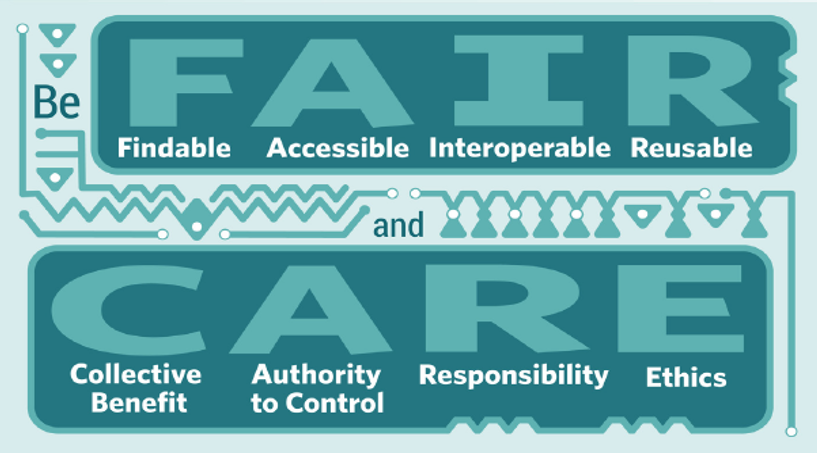How FAIR are your data?
FAIR pinciples
We recommend using the FAIR & CARE principles as guidance to maximize the reusability of your data by you, your collaborators, other researchers, and future-you. Your plan should ensure that detailed documentation adopting existing standards is developed during the entire duration of your project (don’t wait until the very end!!) and that this documentation is archived along with your data and code in a publicly accessible data repository will set you up for success.

A good reference to get you started with FAIR principles: https://perma.cc/CT8P-D5MK
and on CARE principles: https://perma.cc/3ZHR-6JAG
FAIR assessment
Findable
1. Does the dataset have any identifiers assigned?
No identifier
Local identifier
Web address (URL)
Globally unique identifier, citable and persistent (e.g. DOI, PURL, ARK or Handle)
2. Is the dataset identifier included in all metadata records/files describing the data?
No
Yes
3. How is the data described with metadata?
The data are not described
Brief title and description
Comprehensive, but in a text-based, non-standard format
Comprehensively using a recognized formal machine-readable metadata schema
4. What type of repository or registry is the metadata record in?
The data are not described in any repository
Local institutional repository
Domain-specific repository
Generalist public repository
Data are in one place but discoverable through several registries
Accessible
5. How accessible is the data
No access to data or metadata
Access to metadata only
Unspecified conditional access, e.g. contact the data custodian
Embargoed access after a specified date
A de-identified / modified subset of the data is publicly accessible
Fully accessible to persons who meet explicitly stated conditions, e.g. ethics approval for
sensitive data
- Publicly accessible
6. Is the data available online without requiring specialized protocols or tools once access has been approved?
No access to data
By individual arrangement
File download from online location
Non-standard web service (e.g. OpenAPI, Swagger, Informal API)
Standard web service API (e.g. OGC)
7. Will the metadata record be available even if the data are no longer available?
Unsure
No
Yes
Interoperable
8. What (file) formats is the data available in?
Mostly in a proprietary format
In a structured, open standard, non-machine-readable format
In a structured, open standard, machine-readable format
9. What best describes the types of vocabularies/ontologies/tagging schemas used to define the data elements?
Data elements not described
No standards have been applied in the description of data elements
Standardised vocabularies/ontologies/schemas without global identifiers
Standardised, open and universal, using resolvable global identifiers linking to explanations
10. How is the metadata linked to other data and metadata (to enhance context and clearly indicate relationships)?
There are no links to other metadata
The metadata record includes URI links to related metadata, data and definitions
Metadata is represented in machine-readable format, e.g. in a linked format such as
Resource Description Framework (RDF)
Reusable
11. Which of the following best describes the licence/usage rights attached to the data?
No licence
Non-standard text-based licence
Non-standard machine-readable licence (clearly indicating under what conditions the data
may be reused)
Standard text-based licence
Standard machine-readable licence (e.g. Creative Commons)
12. How much provenance information has been captured to facilitate data reuse?
No provenance information is recorded
Partially recorded
Fully recorded in a text format
Fully recorded in a machine-readable format
Acknowledgements
This evaluation portion of this section has been adapted from the UK Data Service https://ukdataservice.ac.uk/app/uploads/exercise_fairdata.pdftarget=“_blank” and is licensed under a Creative Commons Attribution CC-BY 4.0 International License.
